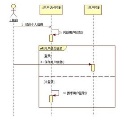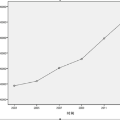The progress in modelling time series and, more generally, sequences of structured data has recently revamped research in anomaly detection. The task stands for identifying abnormal behaviors in financial series, IT systems, aerospace measurements, and the medical domain, where anomaly detection may aid in isolating cases of depression and attend the elderly. Anomaly detection in time series is a complex task since anomalies are rare due to highly non-linear temporal correlations and since the definition of anomalous is sometimes subjective. Here we propose the novel use of Hyperbolic uncertainty for Anomaly Detection (HypAD). HypAD learns self-supervisedly to reconstruct the input signal. We adopt best practices from the state-of-the-art to encode the sequence by an LSTM, jointly learned with a decoder to reconstruct the signal, with the aid of GAN critics. Uncertainty is estimated end-to-end by means of a hyperbolic neural network. By using uncertainty, HypAD may assess whether it is certain about the input signal but it fails to reconstruct it because this is anomalous; or whether the reconstruction error does not necessarily imply anomaly, as the model is uncertain, e.g. a complex but regular input signal. The novel key idea is that a \emph{detectable anomaly} is one where the model is certain but it predicts wrongly. HypAD outperforms the current state-of-the-art for univariate anomaly detection on established benchmarks based on data from NASA, Yahoo, Numenta, Amazon, and Twitter. It also yields state-of-the-art performance on a multivariate dataset of anomaly activities in elderly home residences, and it outperforms the baseline on SWaT. Overall, HypAD yields the lowest false alarms at the best performance rate, thanks to successfully identifying detectable anomalies.
翻译:最近,在建模时间序列和更一般的结构化数据序列方面取得的进展重新振兴了异常检测领域的研究。这项任务旨在识别金融序列、IT系统、航空测量和医学领域等的异常行为,在这些领域,异常检测有助于隔离抑郁症和关注老年人的案例。时间序列中的异常检测是一项复杂的任务,因为异常很少出现,原因在于高度非线性的时间相关性,以及由于异常的定义有时具有主观性。在这里,我们提出了超几何不确定性在异常检测中的新应用(HypAD)。HypAD以自我监督的方式学习重建输入信号。我们采用最先进的最佳实践将序列编码为LSTM,与编码器一起学习通过GAN批评者重构信号。通过超几何神经网络来端到端地估计不确定性。通过使用不确定性,HypAD可以评估是否对输入信号有把握,但它无法重构它,因为这是异常的;或者是模型不确定性,例如一个复杂但正常的输入信号,重构误差不一定意味着异常。新的关键思想是 \emph{可检测的异常} 是模型有把握,但预测错误的异常。在来自NASA、Yahoo、Numenta、亚马逊和Twitter的数据的已建立基准测试中,HypAD优于目前的单变量异常检测的最新技术。它还展示了在老年人住宅异常活动的多变量数据集上最先进的性能,并在SWaT上优于基线。总体而言,由于成功识别可检测的异常,HypAD以最佳性能率提供了最低的虚假警报。



